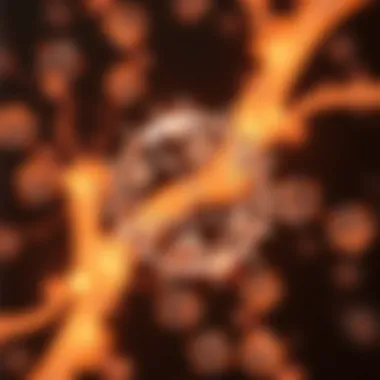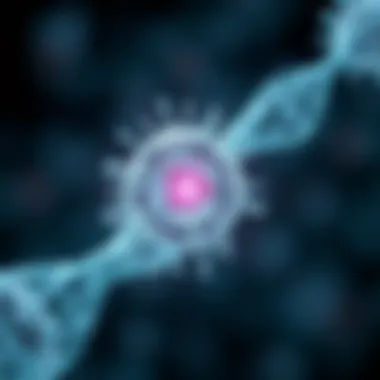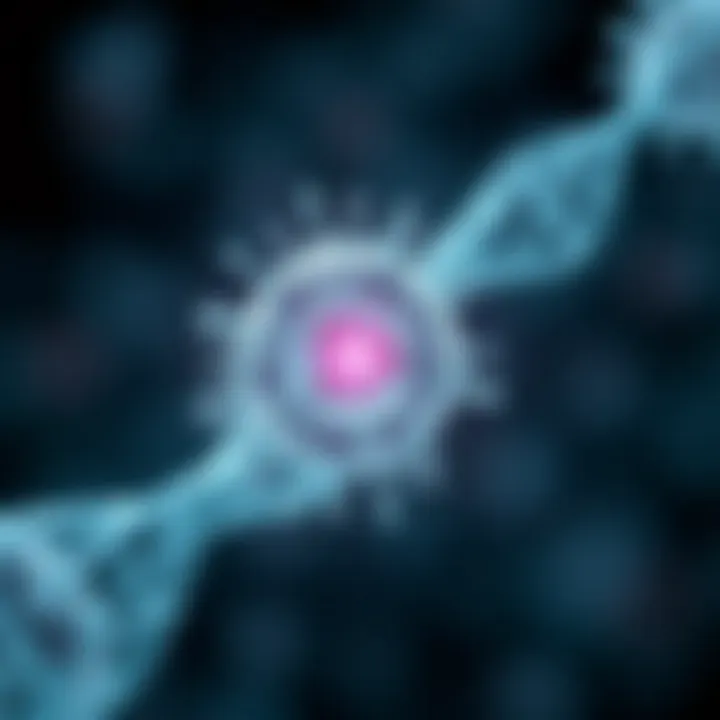Understanding Single Cell Nuclei Sequencing Techniques


Intro
Single cell nuclei sequencing has emerged as a game-changer in the landscape of genomic research, providing a new lens through which the intricacies of biological systems can be examined. Unlike traditional bulk sequencing methods, which average data across millions of cells, this technology allows for the detailed investigation of individual nuclei, revealing the diverse molecular signatures that define cellular identities. This innovation has broadened our understanding of complex biological questions, from developmental biology to oncology and neurobiology, paving the way for breakthroughs previously thought to be out of reach.
The advent of single cell nuclei sequencing signifies a shift in how scientists approach the exploration of cellular diversity. By isolating and analyzing the genetic material from single nuclei, researchers can unearth variations that are critical for understanding disease mechanisms, developmental processes, and even cellular responses to environmental stimuli. As the field evolves rapidly, grasping its methodologies, applications, and the challenges it presents is crucial for students, researchers, educators, and professionals navigating this cutting-edge area of genomic science.
Understanding the methods and relevance of single cell nuclei sequencing not only enhances knowledge but also encourages the application of this technique in various scientific inquiries. Throughout this article, we will delve deeper into the specifics of this technology, assessing its potential to transform our understanding of biology at the most fundamental level. This journey into the realm of single cell analysis promises to unpack the groundbreaking avenues this technology opens up for contemporary scientific exploration.
Research Overview
Single cell nuclei sequencing thrives in its unique ability to shed light on the hidden complexities of cellular function and variation. Let's take a closer look at the emerging findings and background that underscore the significance of this technology.
Summary of Key Findings
- Cellular Heterogeneity: One of the most profound insights from this technology is the extent of heterogeneity among cells in seemingly uniform populations. This discovery holds implications across various fields, from cancer research, where different tumor cells may respond differently to treatment, to developmental biology, where distinct cell identities emerge at different stages.
- Epithelial Tissue Studies: Research focusing on epithelial tissues has shown how single nuclei sequencing can illuminate the role of niche environments in cellular behavior. Understanding these interactions can lead to better insights into tissue regeneration and repair.
- Neurodevelopmental Insights: In neuroscience, single cell nuclei sequencing has facilitated the investigation of complex brain cells, unveiling layers of diversity that inform how neurons function and interact.
Background and Context
The backdrop of single cell sequencing can be traced back to advancements in both genomics and microscopy techniques. Initially, traditional sequencing methods provided a limited perspective, often glossing over the subtleties within cellular populations. With the introduction of high-throughput techniques, the feasibility of analyzing individual nuclei has transformed scientific outlooks.
Moreover, with the continuous development of computational tools and algorithms, processing and interpreting single cell data has become increasingly efficient. These advancements offer researchers the ability to sift through large datasets rapidly, drawing meaningful conclusions from the richness of individual cellular profiles.
As the methodologies have matured, the application of single cell nuclei sequencing is set to transcend beyond basic research, making inroads into translational medicine and precision healthcare. This context sets the stage for understanding the methodology that underpins this powerful tool in genomic science.
Prologue to Single Cell Nuclei Sequencing
Single cell nuclei sequencing has redefined the way researchers approach cellular biology. By allowing for the examination of individual nuclei rather than whole cells, this technique opens the door to a more detailed understanding of the complexity and diversity among cell populations. In an era where the need for precision medicine and personalized therapies is paramount, comprehending these nuances at a microscopic level becomes essential.
Defining Single Cell Nuclei Sequencing
Single cell nuclei sequencing refers to methods that isolate and analyze the genomic material contained within individual cell nuclei. This approach provides a layer of information that traditional sequencing methods struggle to achieve. Instead of aggregating data from many cells and potentially obscuring significant variations, single cell methodologies allow scientists to pinpoint genetic differences and regulatory mechanisms on a cell-by-cell basis. This opens up new avenues for research into various biological functions and pathologies.
Historical Context and Development
The journey to single cell nuclei sequencing is not merely a tale of technological evolution but rather a culmination of decades of scientific inquiry. In the early days of genomics, researchers relied heavily on bulk sequencing techniques that pooled DNA from numerous cells. While effective in some contexts, this method masked the heterogeneity present within tissues.
As technology progressed, the revolutionary advent of single cell RNA sequencing emerged in the late 2000s. This milestone made it clear that an individual cell's transcriptomic profile could offer invaluable insights into cellular behavior. However, as researchers delved deeper, they soon recognized that understanding nuclear DNA was just as critical, if not more so, given that the nucleus holds the genetic blueprint necessary for cellular function.
Subsequent years saw the rise of specialized techniques for isolating nuclei, such as nuclear extraction and microfluidics, cementing the foundation for single cell nuclei sequencing techniques. The combination of these technological advancements with next-generation sequencing platforms laid the groundwork for a profound shift in how we view cellular architecture and identity in both healthy and diseased states.
As we continue to explore the capabilities and limitations of single cell nuclei sequencing, it becomes increasingly evident that this technique is not just another research tool. Rather, it represents a paradigm shift in our understanding of biology itself.
Technological Foundations
The realm of single cell nuclei sequencing is rooted in technological innovations that empower researchers to dissect the complexities of cellular behavior at the tiniest scale. Understanding these technological foundations is crucial as they set the stage for both the precision and the granularity of data that can be generated. The advancements in methodologies allow scientists to unlock secrets hidden within individual cells, revealing insights that are otherwise obscured in bulk populations. This is particularly relevant in fields such as developmental biology, cancer research, and neuroscience, where conventional approaches may falter.
In this section, we will explore the key techniques in isolating single cell nuclei and the various sequencing technologies that form the backbone of this cutting-edge research.
Key Techniques in Single Cell Nuclei Isolation
Isolating single cell nuclei is no small feat. Traditional methods for extracting nuclei often struggled with preserving the integrity of genetic material while avoiding contamination from cellular debris. A few pioneering techniques have emerged over the years to address these challenges.
Ficoll Gradient Centrifugation – This method involves layering a sample over a disaccharide solution. As cells pass through, the nuclei can be separated based on density, resulting in a clearer sample with less extraneous material.
Microfluidic Devices – Using these devices, researchers can manipulate fluids at the microscale. This method provides a streamlined approach to isolate nuclei with high efficiency and minimal damage. The precision of microfluidics allows for effective capture of nuclei with diverse morphologies, yielding more accurate results.
Laser Capture Microdissection (LCM) – LCM utilizes laser technology to selectively isolate nuclei of interest. It can potentially target nuclei from specific tissue types, providing a more nuanced approach that helps elucidate subtle variations among cell types.
In summary, these isolation techniques are significant as they contribute to the high-quality material necessary for subsequent analysis.
Sequencing Technologies


In the evolving landscape of genomics, sequencing technologies play a pivotal role in defining the information that can be extracted from single cell nuclei. Each technology brings unique strengths to the table, making their understanding essential for anyone diving into this field.
Next-Generation Sequencing
Next-Generation Sequencing (NGS) has revolutionized genomics by allowing massive amounts of data to be sequenced in a fraction of the time compared to traditional methods. What makes NGS particularly noteworthy is its scalability; researchers can sequence numerous samples simultaneously without losing resolution. This feature contributes significantly to its popularity in single cell studies.
The lower cost per base in sequencing has enabled broader accessibility for researchers. However, one caveat is the short read lengths, which can create challenges in resolving complex regions of the genome. Nonetheless, NGS remains a cornerstone in the toolkit of genomic analysis for its efficiency and depth of coverage.
Long-Read Sequencing
On the other hand, Long-Read Sequencing offers a different flavor in the sequencing arena. Unlike NGS, this technology can read longer segments of DNA, which is invaluable when assembling genomes that contain repetitive elements. The ability to handle larger fragments of genetic material means that Long-Read Sequencing can provide a more coherent picture of large genomic regions.
However, it typically comes at a higher cost and may have lower throughput compared to its short-read counterparts. Despite these limitations, the unique feature of long reads significantly enhances the ability to identify structural variants, making it an essential choice for researchers looking at complex genetics in single cell contexts.
Error Correction Methods
As with any computation-intensive field, error correction is a vital aspect of sequencing technologies. Error Correction Methods are designed to ensure the reliability of data obtained from sequencing, addressing the frequent mistakes that can occur, particularly in high-throughput settings.
These methods are often based on algorithms that leverage redundant information inherent in sequencing reads. By applying these techniques, researchers can increase confidence in their findings, thereby enhancing the overall quality of genomic data analyses. While employing error correction might add to the complexity of data interpretation, the advantages it provides in terms of accuracy are well worth it, especially in pioneering applications of single cell nuclei sequencing.
Accurate and reliable data from sequencing technologies forms the backbone of any meaningful biological insights derived from single cell analysis.
Applications in Biological Research
The application of single cell nuclei sequencing opens a Pandora's box of opportunities for biological research, allowing scientists to probe into the depth of cellular functions and behaviors like never before. This technology doesn't just scratch the surface; it digs deeply into the minutiae of cellular heterogeneity, developmental processes, and disease mechanisms. Here’s why it matters:
- Cellular Diversity: Understanding that not all cells are cut from the same cloth is fundamental. Some cells can be remarkably different even within the same tissue type, which is something traditional bulk sequencing methods often miss. By focusing on nuclei, researchers are able to capture this diversity in its entirety, providing a detailed map of variations that can inform both basic science and clinical applications.
- Modeling Complex Biological Systems: The intricacies of biological systems are vast. Single cell nuclei sequencing allows for the dissection of these systems at a new level. Researchers can understand how different cell types contribute to overall functionality in tissues and organs, paving the way for more accurate disease models.
- Clinical Implications: By addressing the nuances of cellular behavior, this technology holds the potential to effect change in therapeutic strategies, diagnostics, and prognostics. The implications are profound, influencing fields from pharmacology to regenerative medicine.
Studying Cellular Heterogeneity
Cellular heterogeneity is a cornerstone of biological research. In tissues, even cells that appear similar under a microscope can have vastly different genomic and transcriptomic profiles. Single cell nuclei sequencing allows researchers to unravel these differences, putting them at the forefront of current investigations.
For instance, by analyzing the nuclei of immune cells in a tumor microenvironment, scientists can discover variations that dictate how these cells interact with cancer cells. This could shed light on immune evasion which is critical knowledge for designing effective immunotherapies.
Insights into Developmental Biology
Developmental biology is all about understanding how organisms grow and develop at a cellular level. Single cell nuclei sequencing serves as a powerful microscope for observing these processes in actual living tissues. Instead of assumptions based on averaged data, researchers can view the journey of individual cells throughout development.
For example, when studying embryogenesis, single cell nuclei sequencing can track the genetic signatures that dictate cell fate decisions, helping to illuminate how pluripotent cells differentiate into specialized cells. This knowledge is invaluable, as it can also inform regenerative medicine approaches, where mastering cell differentiation is key.
Impact on Cancer Research
Cancer research stands to benefit significantly from the detailed insights provided by single cell nuclei sequencing. Tumors are often a complex melange of various cell types that can change dynamically in response to treatment, making it essential to dissect them at a single-cell level.
Single cell approaches can identify subpopulations of tumor cells that may have different responses to drugs. For instance, certain cells within a tumor may be resistant to treatment, leading to recurrence or metastasis. Identifying these resistant populations can inform targeted therapies, ultimately improving patient outcomes.
Neuroscience Applications
Neuroscience is another domain where single cell nuclei sequencing is making waves. The complexity of the brain, with its myriad of cell types and interactions, has long posed a challenge to understanding its functions and pathologies.
Utilizing this technology, researchers can classify different neuron and glial cell types more effectively, elucidating their roles in neurological diseases such as Alzheimer’s or Parkinson’s. With a better grasp of individual cell behavior, new avenues for therapeutic interventions may emerge, altering the landscape of treatment options.
"Single cell nuclei sequencing not only charts the nature of cells within tissues but also reveals the stories they tell about health, development, and disease."
In summary, the applications of single cell nuclei sequencing in biological research are vast and impactful. By peeling back the layers of cellular complexity—ranging from individual differences among similar cells to the intricacies of developmental trajectories—this approach is establishing itself as a vital tool across multiple fields of biomedical research.
Challenges and Limitations
The journey into single cell nuclei sequencing isn’t all smooth sailing. Just like any cutting-edge technology, it comes with its own set of hiccups. These challenges and limitations can affect research outcomes and the broader understanding of cell biology. Focusing on these elements is crucial in comprehending the overall impact and applicability of single-cell genomics.
Technical Challenges


Single cell nuclei sequencing is a technical marvel, but it doesn’t come without its bumps in the road. One major challenge is the isolation of nuclei from the cells. It has to be done carefully to prevent degradation or contamination. Techniques like fluorescence-activated cell sorting (FACS) or microfluidics are often employed, but each method carries its own level of complexity and potential for error.
Another sticky situation is the low yield of nucleic acids per cell. Most cells produce only minute amounts of genetic material, making it a tricky endeavor to get enough quality data for reliable analysis. For instance, if a researcher is interested in a rare cell type within a batch of cells, they may wind up with insufficient material to conduct comprehensive sequencing.
Furthermore, single cell data can be noisy. Artifacts from the sequencing process can lead to variations that don’t reflect true biological differences. In fact, distinguishing between technical noise and significant biological variation is often akin to finding a needle in a haystack. Therefore, filtering out noise becomes a vital step for producing meaningful results.
Data Interpretation Issues
Once the sequencing is done, that’s where another can of worms opens up—data interpretation. The volume of data generated in single cell experiments is enormous, which poses problems for analysis. Researchers have to identify meaningful patterns amidst a sea of data points, an endeavor which requires significant computational resources and sophisticated algorithms.
The complexity of single cell data can also result in bias. For instance, if certain genes are overrepresented due to technical limitations, this can skew interpretations about cellular functions. Moreover, classification of cell types based on transcriptomic data can be subjective and may lead to misleading conclusions about cell states or behaviors.
Additionally, reaching consensus about how to represent single cell data remains a challenge. Different labs might adopt various methods or markers, complicating reproducibility and generalization of findings across studies.
Ethical Considerations
As single cell nuclei sequencing continues to develop, the ethical landscape surrounding its use cannot be overlooked. Privacy concerns arise particularly when dealing with human samples. Ensuring that personal genomic data is kept secure and de-identified is of utmost importance. The potential for misuse of such sensitive information is a heavy burden on researchers and institutions alike.
Ethical dilemmas also come into play regarding informed consent. When collecting samples from patients, researchers must ensure that participants understand what their data will be used for, especially in the context of such nuanced approaches as single-cell sequencing. The implications of findings may go far beyond the intended scope, affecting not just the individual but possibly their relatives as well.
Lastly, there are questions about the increase in disparities in access to this technology. The costs associated with high-resolution single-cell analysis might limit its availability to certain institutions or research groups, contributing to unequal opportunities in scientific discovery.
"As we venture deeper into the ethereal realm of single-cell genomics, we must tread carefully, noting the ethical and logistical hurdles that could anchor our progress."
Overall, understanding these challenges is essential for advancing single cell nuclei sequencing as a reliable tool in the biological sciences. Addressing technical difficulties, refining data interpretation methods, and navigating ethical waters will empower researchers to harness the full potential of this transformative technology.
Future Prospects
The realm of single cell nuclei sequencing is standing at a crossroad, where its implications stretch far beyond what we currently comprehend. This section dives deep into the prospects that lie ahead for this transformative technique in genetic research. As technology pushes the envelope, the opportunities for innovation and application will unfold new frontiers in biology and medicine.
Technological Innovations
A significant element on the horizon is the advent of new technological innovations that promise to enhance single cell nuclei sequencing. At the heart of this advancement are high-throughput sequencing platforms, which continue to evolve, providing unprecedented throughput and accuracy. An example is the ongoing development of spatial transcriptomics that integrates spatial information with gene expression data. This combination can reveal not just the identity of individual nuclei, but also their context within the tissue environment.
Another innovation to watch is the rise of microfluidics and automation. By refining sample processing techniques, researchers gain the ability to capture single nuclei under varied conditions with minimal bias, which is vital for accurate biological insights. These tools are likely to lead to more user-friendly and cost-effective methods for labs aiming to adopt this technology without enormous capital expenditure.
Moreover, bioinformatics tools are developing hand-in-hand with sequencing methods. Machine learning approaches are increasingly being utilized to analyze complex datasets emerging from single cell studies. This can significantly shorten the time from raw data to meaningful biological insights, paving the way for more dynamic experiments in real-time.
Integration with Other Genomic Techniques
As the field advances, the integration of single cell nuclei sequencing with other genomic techniques becomes a pivotal aspect to consider. Combining this methodology with CRISPR technology is particularly promising. Through CRISPR, scientists might edit specific genes in single nuclei, followed by sequencing to scrutinize the functional consequences at the cellular level. This synergy allows for not just observation, but active manipulation of genetic material, leading to deeper understanding of gene function.
Moreover, when integrated with proteomics, researchers can obtain a holistic view of cellular behavior. Mapping gene expression together with protein levels in single cells illuminates regulatory networks and interactions, giving researchers a clearer picture of how various factors influence cellular phenotypes. This comprehensive approach could accelerate the understanding of disease mechanisms and lead to novel therapeutic strategies.
Potential Impact on Personalized Medicine
The impact of single cell nuclei sequencing on personalized medicine can't be overstated. By delving into the cellular makeup of individuals, this technique allows for targeted therapies that consider the unique genetic makeup of each patient. In oncology, for instance, identifying specific alterations in cancer cell nuclei could lead to tailored treatments that are far more effective than traditional one-size-fits-all approaches.
Understanding cellular heterogeneity via single cell nuclei sequencing also opens the door to predicting patient responses to treatments. With more data on cellular responses to different drugs, clinicians could optimize therapies based on an individual's unique cellular characteristics, significantly improving outcomes.
"The innovation in sequencing technologies is not just a step forward for genomic research; it’s a leap towards personalized healthcare and therapeutic success."
For more information on technologies and future directions in single cell sequencing, visit Wikipedia or Nature.
With each development, the possibilities expand, painting a future that holds enormous potential not only for scientific inquiry but also for practical applications in health and disease management.
Case Studies
Case studies play an essential role in understanding the practical implications of single cell nuclei sequencing. By examining real-world examples, researchers can not only appreciate the technical capabilities of this technology but also grasp its contributions to various domains of biology and medicine. These case studies illuminate the nuanced applications and outcomes that emerge from conducting single cell nuclei sequencing, providing clarity in complexity.
Single Cell Nuclei Sequencing in Cancer Genomics


In oncology, the application of single cell nuclei sequencing has ushered in a new era of investigation. Take the study of heterogeneity in tumors, for instance. Cancer is not a single disease; it encompasses a wide array of mutations that yield distinct cellular environments within a tumor. Traditional sequencing methods often overlook these variances, painting a broad picture that misses fine details.
Single cell nuclei sequencing allows for a more granular view that can reveal the diverse populations of cells within a tumor. A study published in Nature not too long ago demonstrated this brilliantly. Researchers utilized this sequencing technique to analyze tumor samples from patients with breast cancer. They uncovered subpopulations of cells that exhibited different responses to chemotherapy—some cells were resistant, while others were highly sensitive. This finding can guide treatment decisions and development of targeted therapies, making it invaluable in crafting an effective oncology strategy.
Moreover, by delving into the epigenetic profiles of various nuclei, scientists could identify unique mutations and pathways driving cancer progression. These breakthroughs contribute significantly to personalized treatment plans, ensuring that therapies can be tailored to individual patients’ tumor characteristics.
Applications in Stem Cell Research
Stem cell research has long been a fertile ground for exploring the potential of single cell nuclei sequencing. Understanding how stem cells differentiate into various cell types is critical for both developmental biology and regenerative medicine. Utilizing this technique allows researchers to track the pathways and transitions that stem cells undergo.
In a notable study, researchers focused on embryonic stem cells to elucidate their differentiation into neuronal cells. By sequencing the nuclei of stem cells at different developmental stages, they mapped out key milestones and regulatory factors involved. This approach highlighted the dynamic changes in gene expression as cells transitioned from pluripotent stem cells into specialized neuronal types.
By harnessing single cell nuclei sequencing, scientists can explore not just what genes are turned on or off, but also how these changes correlate with physical transformations of the cell. This understanding opens the door to improved methodologies in cellular reprogramming and tissue engineering, fundamentally impacting the field of regenerative medicine.
"The application of single cell nuclei sequencing in stem cells demonstrates how a detailed approach can lead to breakthrough insights into complex biological development".
These case studies, whether in cancer genomics or stem cell research, highlight the versatility and significance of single cell nuclei sequencing. They not only showcase the potential of this technology in advancing scientific understanding but also illustrate its practical implications in healthcare and therapeutic development, paving the way for more tailored and effective interventions.
Comparative Insights
The section on comparative insights plays a crucial role in understanding the broader context of single cell nuclei sequencing within genomic research. Highlighting the disparities between various cellular sequencing methods allows scientists, researchers, and educators to get a clearer picture of how single cell nuclei sequencing stands out. This comparison not only showcases the unique selling points of this technology but also brings to light its limitations in contrast to other techniques.
Single Cell Nuclei vs. Whole Cell Sequencing
Single cell nuclei sequencing and whole cell sequencing are often viewed through the same lens, but they serve different purposes that cater to specific scientific queries. While both methods aim to unravel the genomic landscape, the nuances of their methodologies result in distinct types of data.
Separation at the Nucleus
Single cell nuclei sequencing focuses on the nuclei of cells, effectively bypassing the cytoplasmic content. This can be particularly advantageous for studying gene expression at the nuclear level, which plays a significant role in understanding cellular function and disease states. For instance, while whole cell sequencing may capture a variety of RNA molecules, single cell nuclei sequencing zeroes in on what's happening within the nucleus at that exact moment.
The Draw of Whole Cell Sequencing
On the flip side, whole cell sequencing encompasses a holistic approach, analyzing both the cytoplasm and nucleus. This can yield richer datasets, especially when examining proteomic and metabolomic contexts, which may be lost in nuclei-only evaluations. However, this comprehensive view comes at the cost of increased complexity in data interpretation and potential dilution of signals from low-abundance transcripts.
In practice, choosing between single cell nuclei and whole cell sequencing often depends on the research objectives. For instance, studying the transcription factors or chromatin states in developmental biology may benefit from nuclei sequencing, while exploring cellular metabolism or viral infections might necessitate a whole cell approach. A thorough understanding of these differences is thus imperative for researchers aiming to select the most appropriate method for their specific scientific inquiries.
Strengths and Weaknesses
Every approach in scientific research has its strengths and weaknesses, and single cell nuclei sequencing is no exception.
Strengths
- Higher Resolution: Single cell nuclei sequencing offers a more precise look at nuclear gene expression, which can reveal subtle differences among individual cells that might be masked in bulk analyses.
- Focus on Nucleotide-Level Data: This technique isolates and sequences nuclear DNA and RNA, providing insights into transcriptional activity and epigenetic modifications.
- Reduced Cellular Noise: By examining nuclei exclusively, researchers can minimize the impact of cellular components that may confound results.
Weaknesses
- Technical Limitations: The isolation and sequencing of nuclei can be more challenging than whole cell methods, making replicates less consistent.
- Data Complexity: Interpretation of the data is not always straightforward; sometimes, nuclear RNA profiles do not fully represent the complexities of whole-cell states.
- Cost Implications: Often, the sequencing of nuclei can demand more resources, leading to higher operational expenditures compared to some whole cell techniques.
The comparative insights into these methodologies enhance the foundational understanding necessary for navigating the complexities of genomic research. Such analysis not only makes clear the importance of single cell nuclei sequencing but also sheds light on its position relative to whole cell techniques, ultimately guiding choice in research methodologies.
Culmination
As we draw the curtain on our exploration of single cell nuclei sequencing, it becomes abundantly clear that this technology represents a monumental stride in genomic research. The significance of this topic lies not just in its innovative methodologies, but also in the profound insights it offers into the intricate biology of cells.
Summary of Key Findings
Single cell nuclei sequencing stands as a pioneering tool, pushing the boundaries of our understanding in several critical areas:
- Cellular Diversity: It allows researchers to dissect the cellular composition of tissues with exceptional resolution, revealing subtle differences that would be lost in bulk analyses.
- Applications Across Disciplines: From cancer genomics to neuroscience, its versatility is unmatched. This technology has opened new doors in developmental biology by highlighting crucial stages in cell differentiation and lineage tracing.
- Methodological Innovations: The techniques for isolating nuclei, paired with sophisticated sequencing methods, reflect the dynamic nature of the field and its capacity for growth and adaptation. Emerging innovations promise further finesse in efficiency and accuracy.
Though challenges remain, particularly in data interpretation and ethical considerations, the advancements in this area underscore its potential to fuel breakthroughs in personalized medicine and beyond.
Final Thoughts on Future Directions
Looking ahead, it’s imperative that both researchers and practitioners remain vigilant about the evolving landscape of single cell nuclei sequencing. Future advancements could take shape in several ways:
- Integration with Multi-Omics: There is enormous potential in combining single cell nuclei sequencing with other omics technologies. Such integrative approaches could yield a more holistic view of cellular functions and interactions.
- Enhanced Data Analysis Tools: As datasets grow increasingly complex, developing robust bioinformatics tools will be crucial for effective data management and interpretation.
- Ethical Frameworks: Navigating the ethical implications will be essential to ensure responsible research practices. Addressing privacy, consent, and the potential for misuse of data must be part of the future dialogue.
In summation, the road ahead for single cell nuclei sequencing is both bright and fraught with challenges. The promising implications for understanding biological systems and advancing medical research make it a field worth observing closely. As researchers continue to innovate and refine these methodologies, the overall impact on scientific inquiry holds the potential to be transformational.







